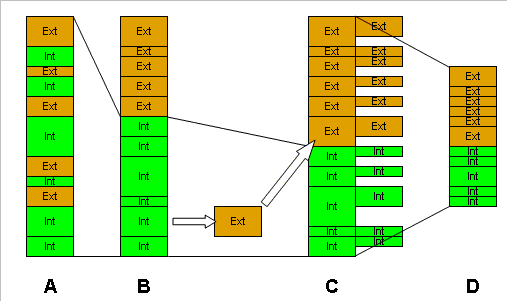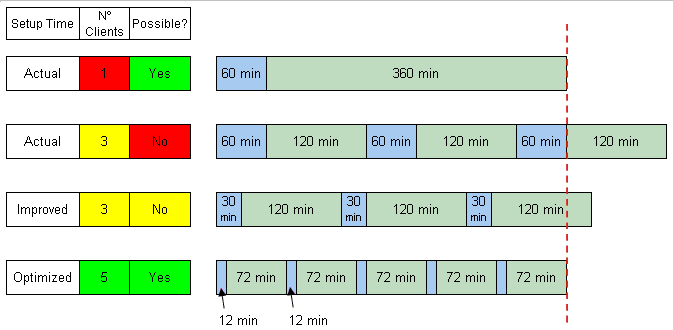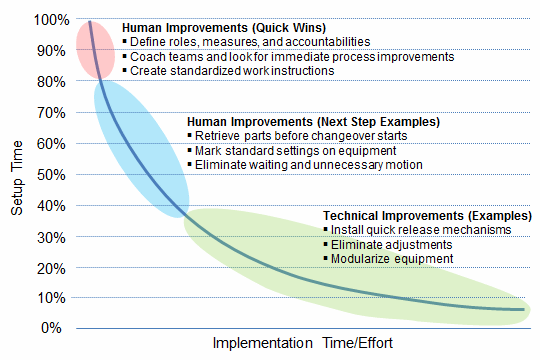


 |

|

|
|
GOLF |
|
||
Single-Minute Exchange
of Die (SMED)
is one of the many lean production methods for reducing waste in a
manufacturing process. It provides a rapid and efficient way of converting a
manufacturing process from running the current product to running the next
product. This rapid changeover is key to reducing production lot sizes and
thereby improving flow (Mura).
The phrase "single
minute" does not mean that all changeovers and startups should take only one minute, but that they should take less
than 10 minutes (in other words, "single-digit minute"). Closely associated is a yet more
difficult concept, One-Touch
Exchange of Die, (OTED),
which says changeovers can and should take less than 100 seconds. ADie is
a tool used in manufacturing. However SMED's utility of is not limited to
manufacturing (see value stream mapping).
The method can be
extended to reduction of �Cycle Time� for any activity like �Overhauling� of
equipment, �Installation� of manufacturing set-up, equipment, Projects like
power plant installation & commissioning etc.
The concept arose in
the late 1950s and early 1960s, when Shigeo Shingo was consulting to a variety of
companies including Toyota, and was contemplating their inability to eliminate
bottlenecks at car body-moulding presses. The bottlenecks were caused by long
tool changeover times, which drove up production lot sizes. The economic lot
size is calculated from the ratio of actual production time and the
'change-over' time; which is the time taken to stop production of a product and
start production of the same, or another, product. If changeover takes a long
time then the lost production due to changeovers drives up the cost of the
actual production itself. This can be seen from the table below where the changeover
and processing time per unit are held constant whilst the lot size is changed.
The Operation time is the unit processing time with the overhead of the
changeover included. The Ratio is the percentage increase in effective
operating time caused by the changeover. SMED is the key to manufacturing
flexibility.
|
Changeover time |
Lot size |
Process time per item |
Operation time |
Ratio |
|
8 hours |
100 |
1 min |
5.8 min |
480% |
|
8 hours |
1,000 |
1 min |
1.48 min |
48% |
|
8 hours |
10,000 |
1 min |
1.048 min |
5% |
Toyota's additional
problem was that land costs in Japan are very high and therefore it was
very expensive to store its vehicles. The result was that its costs were higher
than other producers because it had to produce vehicles in uneconomic lots.
The "economic lot size"
(or EOQ, Economic Order Quantity) is a well-known, and heavily debated, manufacturing concept. Historically,
the overhead costs of retooling a process were minimized by maximizing the
number of items that the process should construct before changing to another
model. This makes the changeover overhead per manufactured unit low. According
to some sources optimum lot size occurs when the interest costs of storing the
lot size of items equals the value lost when the production line is shut down.
The difference, for Toyota, was that the economic lot size calculation included
high overhead costs to pay for the land to store the vehicles. Engineer Shingo
could do nothing about the interest rate, but he had total control of the
factory processes. If the changeover costs could be reduced, then the economic
lot size could be reduced, directly reducing expenses. Indeed the whole debate
over EOQ becomes restructured if still relevant. It should also be
noted that large lot sizes require higher
stock levels to be kept in the rest of the process and these, more hidden
costs, are also reduced by the smaller lot sizes made possible by SMED.
Over a period of
several years, Toyota reworked factory fixtures and vehicle components to
maximize their common parts, minimize and standardize assembly tools and steps,
and utilize common tooling. These common parts or tooling reduced changeover
time. Wherever the tooling could not be common, steps were taken to make the
tooling quick to change.
Shigeo Shingo, who
created the SMED approach, claims that
in his data from between 1975 and 1985 that average set-up times he has dealt
with have reduced to 2.5% of the time originally required; a 40 times
improvement.
However, the power of
SMED is that it has a lot of other effects, which come from systematically
looking at operations; these include:
�
Stockless production which drives inventory
turnover rates,
�
Reduction in footprint of processes with reduced
inventory freeing floor space
�
Productivity increases or reduced production
time
�
Increased machine work rates from reduced setup
times even if number of changeovers increases
�
Elimination of setup errors and elimination of
trial runs reduces defect rates
�
Improved quality from fully regulated operating
conditions in advance
�
Increased safety from simpler set-ups
�
Simplified housekeeping from fewer tools and
better organization
�
Lower expense of set-ups
�
Operator preferred since easier to achieve
�
Lower skill requirements since changes are now
designed into the process rather than a matter of skilled judgment
�
Elimination of unusable stock from model
changeovers and demand estimate errors
�
Goods are not lost through deterioration
�
Ability to mix production gives flexibility and
further inventory reductions as well as opening the door to revolutionized
production methods (large orders ≠ large production lot sizes)
�
New attitudes on controllability of work process
amongst staff
Shigeo Shingo
recognises eight techniques that
should be considered in implementing SMED.
1. Separate
internal from external setup operations
2. Convert
internal to external set-up
3. Standardize
function, not shape
4. Use
functional clamps or eliminate fasteners altogether
5. Use
intermediate jigs
6. Adopt
parallel operations (see image below)
7. Eliminate
adjustments
8. Mechanization
NB External set-up can
be done without the line being stopped whereas internal setup requires that the
line be stopped.
He suggests that SMED improvement should pass
through four conceptual stages:
A) Ensure
that external set-up actions are performed while the machine is still running,
B) Separate external and
internal set-up actions, ensure that the parts all function and implement
efficient ways of transporting the die and other parts,
C) Convert
internal set-up actions to external,
D) Improve all set-up actions.


There are seven basic
steps to reducing changeover
using the SMED system:
1. OBSERVE
the current methodology (A)
2. Separate
the INTERNAL and EXTERNAL activities (B). Internal activities are those that
can only be performed when the process is stopped, while External activities
can be done while the last batch is being produced, or once the next batch has
started. For example, go and get the required tools for the job BEFORE the
machine stops.
3. Convert
(where possible) Internal activities into External ones (C) (pre-heating of
tools is a good example of this).
4. Streamline
the remaining internal activities, by simplifying them (D). Focus on fixings - Shigeo Shingo observed that it's only the last turn
of a bolt that tightens it - the rest is just movement.
5. Streamline
the External activities, so that they are of a similar scale to the Internal
ones (D).
6. Document
the new procedure, and actions that are yet to be completed.
7. Do
it all again: For each iteration of the above process, a 45% improvement in
set-up times should be expected, so it may take several iterations to cross the
ten-minute line.
This diagram shows four
successive runs with learning from each run and improvements applied before the
next.
�
Run 1 illustrates the original situation.
�
Run 2 shows what would happen if more
changeovers were included.
�
Run 3 shows the impact of the improvements in
changeover times that come from doing more of them and building learning into
their execution.
�
Run 4 shows how these improvements can get you
back to the same production time but now with more flexibility in production
capacity.
�
Run N (not illustrated) would have changeovers
that take 1.5 minutes (97% reduction) and whole shift time reduced from 420
minutes to 368 minutes a productivity improvement of 12%.
The
SMED concept is credited to Shigeo Shingo, one of the main
contributors to the consolidation of the Toyota Production System, along with Taiichi Ohno.


